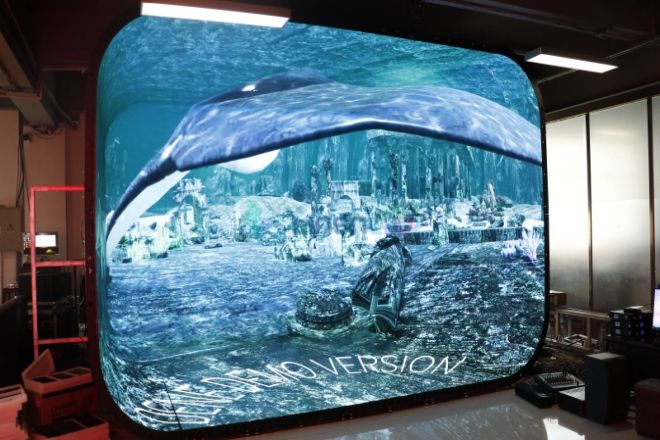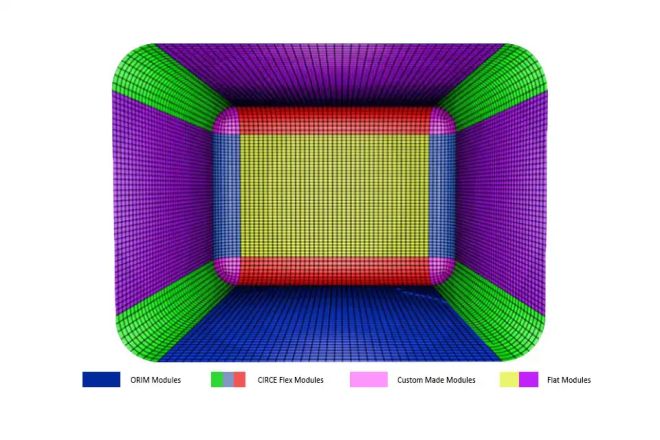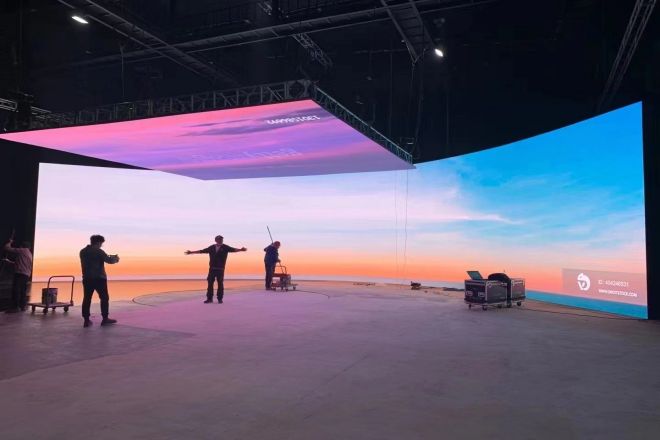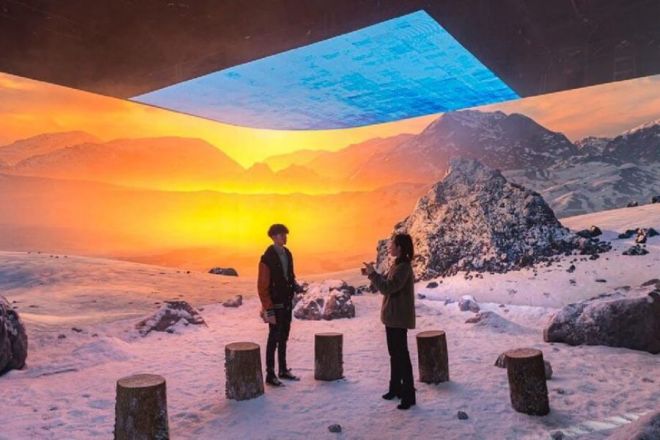Introduction

À l’ère du numérique, Affichage LED technology has quickly become an important medium for information display and visual communication, and it has unique advantages. With the advancement of science and technology and the improvement of people’s aesthetic needs, immersive LED displays, as a new display technology, are gradually coming into people’s vision and showing broad application prospects in various fields.
The immersive LED display brings people an unprecedented visual experience with its ultra-large size, high-definition quality, and seamless splicing. It can completely wrap the audience in the picture, creating an immersive feeling and making the audience feel as if they are in a real, three-dimensional virtual world.
This immersive experience not only greatly enhances the audience’s sense of participation and interactivity but also provides companies and brands with new publicity and promotion methods.
1. Qu’est-ce qu’un écran LED immersif ?

Immersive LED display is a technology that uses large-scale LED screens as display media.
It uses advanced image processing and projection technology to bring users a multi-dimensional and three-dimensional visual experience. It can bring users into a virtual, highly realistic environment, giving users an immersive experience.
The characteristics of the immersive LED display include ultra-large screen and high-definition resolution, which provide users with clearer and more detailed picture effects.
At the same time, LED display combinations of various shapes, such as strip screens, flat screens, curved screens, multi-sided screens, special-shaped screens, floor tile screens, etc., can create an immersive space aesthetic according to local conditions and further enhance the user’s visual experience.
In addition, immersive LED displays often combine advanced technological means, such as holographic projection, AR (augmented reality), VR (virtual reality), 5G and AI, etc., to create a more extreme real experience. The addition of these technical means makes immersive LED displays have broad application prospects in entertainment, education, commercial display, and other fields.
2. What is the difference between immersive LED displays and traditional displays?
Compared with traditional displays, immersive LED displays have many obvious differences. These differences are explained in detail below:
- First of all, from the perspective of visual experience and effects:
Immersive LED displays undoubtedly have significant advantages. Its large screen size and extremely high resolution make the picture display more delicate and clear, and the colors more vivid and realistic. This gives users an immersive experience as if they are in a real, multi-dimensional environment. In comparison, traditional displays may be limited in size and resolution and fail to deliver the same level of visual impact.
- Secondly, immersive LED displays have greater flexibility in form and shape:
It can adopt a variety of LED display combinations according to different application scenarios and needs, such as bar screens, flat screens, curved screens, multi-sided screens, special-shaped screens, floor tile screens, etc.
This diversified form design enables the immersive LED display to better adapt to various environments and bring a richer visual experience to users. Traditional displays are often limited to fixed shapes and sizes and cannot provide such diverse choices.
- Furthermore, the immersive LED display screen is interactive and innovative:
It can achieve real-time interaction with users through advanced image processing and projection technology, providing users with a more personalized experience. At the same time, immersive LED displays can also combine a variety of technical means, such as holographic projection, AR (augmented reality), VR (virtual reality), etc., to create a more realistic and vivid virtual environment, making users feel as if they are in a real world, in the three-dimensional world.
This innovative application method makes immersive LED displays have broad application prospects in entertainment, education, commercial display, and other fields.
- In addition, from the perspective of energy consumption and environmental protection:
Immersive LED displays also have certain advantages. LED screens consume less energy and have a longer service life than traditional displays, which helps reduce energy consumption and environmental pollution.
At the same time, with the continuous advancement of technology, the energy efficiency of immersive LED displays is also constantly improving, making positive contributions to environmental protection.
- Finally, from the perspective of application scenarios:
Immersive LED displays have a wider range of applications. It can be used in entertainment venues such as cinemas and game halls to provide users with a more realistic viewing and gaming experience; it can also be used in commercial displays to enhance brand image and sales performance by attracting the audience’s attention.
It can also be used in the field of education and training, we help students better understand and master knowledge. Traditional displays are more limited to indoor environments and small display needs.
3. What are the benefits of using immersive LED displays?

The use of immersive LED displays has many benefits, which are not only reflected in the improvement of visual experience but also cover the expansion of application fields, energy conservation, and environmental protection.
Tout d'abord, immersive LED displays can bring users the ultimate visual experience. Its large screen size, high-definition resolution, and seamless splicing make the picture more delicate and clear and the colors more vivid and full. At the same time, combined with advanced image processing technology, it can present a more realistic picture effect, making users feel as if they are in a real three-dimensional space and gain an immersive feeling.
This immersive experience not only improves the user’s viewing experience but also provides companies and brands with more effective publicity and promotion methods.
Deuxièmement, immersive LED displays have a wide range of applications. It can be used in many fields, such as commercial advertising, brand display, culture and art, sports events, education and training, etc. In the commercial field, advertising and brand images displayed through immersive LED displays can attract more customers’ attention and improve sales performance.
In the field of culture and art, it can bring a richer viewing experience to the audience and improve the display effect of artworks. In the field of education and training, teaching content displayed through immersive LED displays can help students better understand and master knowledge and improve learning effects.
En outre, immersive LED displays also have the advantages of saving energy and protecting the environment. LED screens have lower energy consumption and longer service life than traditional displays, which helps reduce energy consumption and environmental pollution.
At the same time, with the continuous advancement of technology, the energy efficiency of immersive LED displays is also constantly improving, making positive contributions to environmental protection.
Enfin, immersive LED displays are also highly flexible and customizable. It can be designed and adjusted in shape and size according to different application scenarios and needs to meet the personalized needs of users.
This flexibility and customizability enable immersive LED displays to better adapt to various environments and provide users with a better visual experience.
4. What are the application scenarios of immersive LED displays?
Immersive LED displays have a wide range of application scenarios, and their unique visual experience and interactivity make them excellent in many fields. The following are some main application scenarios:
1). Commercial display and advertising:
In public places such as shopping malls, shopping malls, and airports, immersive LED displays can be used as billboards or display walls to attract customers’ attention and enhance brand image through their high-definition, lifelike images.
In the car showroom, immersive LED displays are used to display various details and functional features of the car, providing customers with a more intuitive and vivid car buying experience.
2). Entertainment and leisure:
In entertainment venues such as movie theaters and game arcades, immersive LED displays can bring users a more realistic viewing and gaming experience and enhance the entertainment effect.
In KTV, bars, and other leisure places, immersive LED displays create a unique atmosphere and enhance consumers’ experience.
3). Education and training:
In educational places such as schools and training institutions, immersive LED displays can be used for multimedia teaching to present abstract knowledge to students in an intuitive and vivid form, improving students’ learning interest and effectiveness.
In the science laboratory, students can observe the microscopic world and understand astronomical knowledge through the immersive LED display, broadening their horizons and enriching their knowledge.
4). Culture, art, and exhibitions:
In cultural venues such as museums and art galleries, immersive LED displays are used to display artworks or historical relics, bringing a new viewing experience to the audience.
In various exhibitions and activities, immersive LED displays can be used as background screens or display screens to enhance the exhibition effect and the audience’s sense of participation.
5). Stadiums and events:
In stadiums, stadiums, and other venues, immersive LED displays can be used as game background screens or audience interactive screens to enhance the game atmosphere and audience participation.
In large-scale events or activities, immersive LED displays are used for live broadcasts or playback, bringing a more shocking visual experience to the audience.
6). Urban landscape and public space:
In public spaces such as urban landmarks and squares, immersive LED displays can be used as decoration and display tools to enhance the city’s image and cultural atmosphere.
In festival celebrations, light shows, and other activities, immersive LED displays are used to create a unique visual feast, attracting citizens and tourists to stop and watch.
5. How do immersive LED displays compare to other immersive technologies like VR and AR?

Compared with other immersive technologies such as VR (virtual reality) and AR (augmented reality), immersive LED displays have their own unique features.
Tout d'abord, immersive LED displays mainly use large LED screens and advanced image processing technology to bring users a multi-dimensional and three-dimensional display environment. Its advantage is that it can provide ultra-high definition, lifelike picture quality, a wider viewing angle, and more realistic color performance.
Users can get an immersive visual experience in this environment without wearing any equipment. However, its immersion mainly relies on the creation of visual effects, with relatively little stimulation of other senses.
Deuxièmement, VR technology creates a completely virtual environment for users through special helmet-mounted displays, gloves, and other equipment, in which users can freely explore and interact.
VR technology is very immersive and can provide users with a full range of sensory experiences, including vision, hearing, and even touch. However, the use of VR equipment may be subject to some limitations, such as the weight of the equipment, wearing comfort, and range of activities during use.
Enfin, AR technology superimposes virtual information into the real world. Users can experience and interact with this virtual information through devices such as mobile phones, tablets, or specialized AR glasses. The advantage of AR technology is that it can bring additional information and experience to users without changing the real environment.
However, the implementation of AR technology usually relies on specific equipment and software, and the degree of integration of virtual information with the real world may be subject to some technical limitations.
To sum up, immersive LED displays and VR and AR technologies each have their own advantages and applicable scenarios. Immersive LED displays are more suitable for large-scale, public display environments, such as shopping malls, museums, etc.
VR technology is more suitable for applications that require a high degree of immersion and all-round sensory experience, such as games, education, etc.; and AR technology is more suitable for scenarios where virtual information needs to be added to the real environment, such as navigation, tourism, etc
In actual applications, the appropriate technology can be selected according to specific needs and scenarios.
Conclusion
In short, as a new display technology, the immersive LED display screen is becoming an important tool for information display and visual communication with its unique advantages and wide range of application scenarios.
Si vous souhaitez en savoir plus sur les écrans LED, merci de nous contacter.
